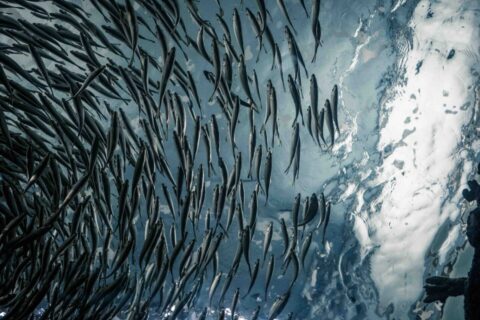News
Our Favorites Stories of 2025
Food•5 min read
Perspective
Trump recently signed an order to deregulate and greenlight new industrial fish farms. But virtually no thought has been given to those most impacted by these operations: the fish themselves.


Words by Jonathan Balcombe
COVID-19 has demonstrated how, in so many ways, our industrial animal food system is broken. Yet, despite the increasing impetus for change, factory farming may have just gotten its greatest boost in decades. And it comes from an executive order you’ve never heard of, and from an industry you probably know little or nothing about: fish farming.
On May 7, President Trump signed an executive order that seeks to reshape the seafood industry. It contains a number of broad directives, including slashing timelines for new fish farms as well as an order to “identify and remove unnecessary regulatory barriers restricting American fishermen and aquaculture producers.”
What does all this mean?
It means we’re likely to see a whole lot more intensive fish farms in America’s waters in the coming years. How ironic, that at a time when the link between pandemics and animal production systems is increasingly clear, our leaders choose to double down on more intensive animal farming.
If you are like most seafood consumers, you probably have little idea of where your seafood comes from. Forget the romantic image of fishermen braving the seas to haul in a catch. Today, for the first time in history, most of the fish people eat are raised on fish farms. Fish farms vary from ponds to tanks to raceways, but Trump’s order specifically earmarks offshore systems for expansion. These are massive, floating cages, each of which can hold hundreds of thousands of fish. With such a concentration of animals, sea cages are prone to disease outbreaks, parasites, pollution of surrounding waters, high mortality rates, and mass escape of non-native species that can disrupt the local gene pool.
There are myriad reasons to oppose Trump’s order: environmental groups have already written about the ensuing devastation if ocean aquaculture expands. No wonder local fishermen and small-scale aquaculture producers, whose businesses stand to be jeopardized by the increased monetization of our oceans, have also spoken out in opposition.
However, there has been virtually no focus on those who this order affects most: the billions more fish who may now be raised in these intensive systems.
It’s no surprise that throwing hundreds of thousands of animals into a cage might not be a recipe for happiness: farmed fish endure various causes of pain and suffering. Sometimes these are a result of “bad apple” workers, but most of the time the workers are doing the best they can. Rather, there are simply chronic causes of suffering when animals who normally migrate hundreds of miles or more are kept crowded and caged.
Sea lice are a common cause of suffering in these unnaturally crowded operations: these very visible parasites latch on and multiply as they feed off the fish’s flesh, which they do in particular abundance in salmon farms. Diseases and infections proliferate, resulting in fish whose scales look like they’ve been eaten off their faces.
These infections and infestations have a spillover effect on the natural ecosystem: one study found that wild fish collected near farms were 16 times more likely to play host to parasites and disease. It was largely for this reason that in 2018, Washington state banned offshore salmon farms altogether.
Intensively farmed fish also fall victim to deformities at alarmingly high rates. Several investigations have shown horrific instances of fish with twisted S-shaped spines and mouths that appear as though they have been crushed and disfigured. Another study found that farmed fish suffer from hearing impairments at rates over 10 times higher than their wild brethren (yes, not only are fish capable of feeling pain, but they can hear as well).
Fortunately, President Trump’s order does include some positive elements, such as guidelines to combat illegal, unreported, and unregulated fishing. This is an important step to dealing with the roughly 20-30 percent of imported seafood that comes from such harmful operations. Additional action on this front should be taken.
These are complicated problems, and their solution is not further deregulation released while everyone is busy fighting the coronavirus. Given the vast environmental, financial, and ethical implications of the President’s dubious ambition to make the U.S. “the world’s seafood superpower,” the way forward must involve greater scrutiny and foresight, not less. We as a nation must decide thoughtfully and in the light of day, not in the chaos of a pandemic, how we are to reconcile food production with ethical responsibility and environmental sustainability.
Trump’s executive order is supposedly about “revolutionizing American seafood production” and “improving the quality of American lives”. But will further corporate consolidation really improve the lives of our coastal fishing businesses when they are just struggling to stay afloat? In an era of unprecedented public awareness of the ills of animal agriculture for public health, the environment, and animals, the last thing America needs is more factory farms.